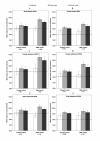Secular trends: a ten-year comparison of the amount and type of physical activity and inactivity of random samples of adolescents in the Czech Republic
- PMID: 21943194
- PMCID: PMC3192689
- DOI: 10.1186/1471-2458-11-731
Secular trends: a ten-year comparison of the amount and type of physical activity and inactivity of random samples of adolescents in the Czech Republic
Abstract
Background: An optimal level of physical activity (PA) in adolescence influences the level of PA in adulthood. Although PA declines with age have been demonstrated repeatedly, few studies have been carried out on secular trends. The present study assessed levels, types and secular trends of PA and sedentary behaviour of a sample of adolescents in the Czech Republic.
Methods: The study comprised two cross-sectional cohorts of adolescents ten years apart. The analysis compared data collected through a week-long monitoring of adolescents' PA in 1998-2000 and 2008-2010. Adolescents wore either Yamax SW-701 or Omron HJ-105 pedometer continuously for 7 days (at least 10 hours per day) excluding sleeping, hygiene and bathing. They also recorded their number of steps per day, the type and duration of PA and sedentary behaviour (in minutes) on record sheets. In total, 902 adolescents (410 boys; 492 girls) aged 14-18 were eligible for analysis.
Results: Overweight and obesity in Czech adolescents participating in this study increased from 5.5% (older cohort, 1998-2000) to 10.4% (younger cohort, 2008-2010). There were no inter-cohort significant changes in the total amount of sedentary behaviour in boys. However in girls, on weekdays, there was a significant increase in the total duration of sedentary behaviour of the younger cohort (2008-2010) compared with the older one (1998-2000). Studying and screen time (television and computer) were among the main sedentary behaviours in Czech adolescents. The types of sedentary behaviour also changed: watching TV (1998-2000) was replaced by time spent on computers (2008-2010).The Czech health-related criterion (achieving 11,000 steps per day) decreased only in boys from 68% (1998-2000) to 55% (2008-2010). Across both genders, 55%-75% of Czech adolescents met the health-related criterion of recommended steps per day, however less participants in the younger cohort (2008-2010) met this criterion than in the older cohort (1998-2000) ten years ago. Adolescents' PA levels for the monitored periods of 1998-2000 and 2008-2010 suggest a secular decrease in the weekly number of steps achieved by adolescent boys and girls.
Conclusion: In the younger cohort (2008-2010), every tenth adolescent was either overweight or obese; roughly twice the rate when compared to the older cohort (1998-2000). Sedentary behaviour seems relatively stable across the two cohorts as the increased time that the younger cohort (2008-2010) spent on computers is compensated with an equally decreased time spent watching TV or studying. Across both cohorts about half to three quarters of the adolescents met the health-related criterion for achieved number of steps. The findings show a secular decrease in PA amongst adolescents. The significant interaction effects (cohort × age; and cohort × gender) that this study found suggested that secular trends in PA differ by age and gender.
Figures



References
-
- Azevedo MR, Araújo CL, Da Silva MC, Hallal PC. Tracking of physical activity from adolescence to adulthood: a population-based study. Revista de Saude Publica. 2007;41:69–75. - PubMed
-
- Gordon-Larsen P, Nelson MC, Popkin BM. Longitudinal physical activity and sedentary behavior trends: Adolescence to adulthood. American Journal of Preventive Medicine. 2004;27(4):277–283. - PubMed
Publication types
MeSH terms
LinkOut - more resources
Full Text Sources
Medical
Miscellaneous

